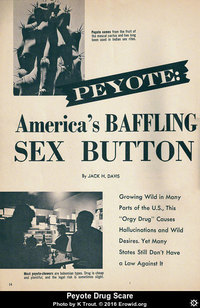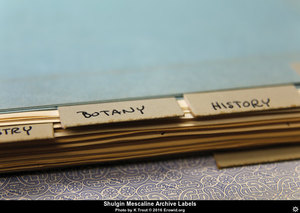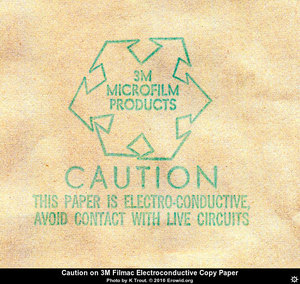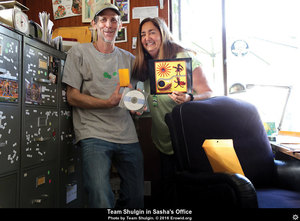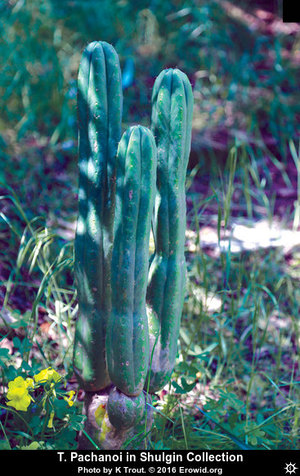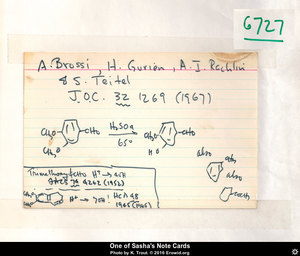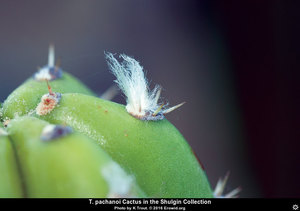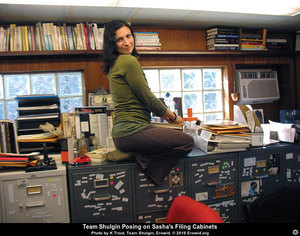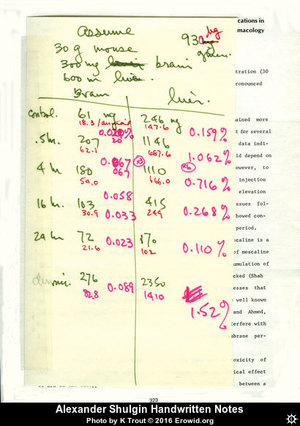Sasha's Peyote & Mescaline Files
Excavating and Digitizing the Cactus Papers
Feb 2016
Citation: Trout K. "Sasha's Peyote & Mescaline Files: Excavating and Digitizing the Cactus Papers". Erowid Extracts. Feb 2016;28:12-17. Online edition: Erowid.org/culture/plants/peyote_article6.shtml
My involvement in the archiving process has mostly been limited to scanning and understanding Sasha's mescaline files. These items had once been intended by Sasha to serve as the reference basis for an ambitious first book that he was writing on peyotl and mescaline during the 1960s. Sasha's book on peyote was never completed and instead he repackaged a very abbreviated set of some of its highlights as a chapter within TiHKAL.
When many people picture the archiving of historical collections, they imagine conservators with white cloth gloves in clean rooms, protecting rare and precious originals. The work at the Shulgin Farm is somewhat different. When gloves are involved, they might be to protect the wearer, not the relic.
The process began long before I arrived, with Tania valiantly removing more than a thousand staples on my behalf, replacing them with paperclips to make my part of the scanning efforts go more smoothly. During that process, her hands travelled through more than four "linear file feet" of articles, letters, and note pages related to mescaline.
The vast majority of the papers are printed copies of articles from various scientific journals and assorted nonscientific publications ranging from a Huichol art show portfolio, to Congressional hearings, to a Pentecostal tract damning peyote as a tool of enslavement.
This causes some interesting challenges in photocopying. For instance, Sasha sometimes taped a Chemical or Biological Abstracts entry on top of other text, requiring it be lifted to read the text beneath. In several cases he made such an entry deliberately and included the handwritten instruction to "lift". These obviously require a separate scan in the lifted and resting positions to read all of the text.
There are also sets of unique hybrid photocopies that had failed to copy legibly on the lower third of the paper. Rather than just replace them with new versions, each missing section had been copied again and taped over the length of the blank part of each page. Printing and photocopying annoyances are multi-generational.
Sasha's dirty pictures and handwritten notes appear scattered throughout the papers. One of my favorite comments, on "Phencyclidine, lysergic acid diethylamide, and mescaline: cerebral artery spasms and hallucinogenic activity", simply says, "General Hypotheses, written by idiots".
Correspondence with other chemists was illuminating, especially during the periods of active discovery of molecules like TMA and the pre-scheduling days of MDMA. Sasha's conversations not only add to the known history of these molecules, but also shed light on the sheer volume of work he was accomplishing and how he approached the process of discovery. In a letter to Thornton Sargent early in 1966, Sasha describes the details of eight projects that he was actively pursuing. He then described project nine as his need to "get started on at least one" of an additional eight projects.
I thought that Sasha's comment of needing to get "off of the dime and into the vacuum line" in order to complete a pending synthesis was a wonderful phrase.
While noting lophophine to be significantly less potent than mescaline (requiring 50% more material than the typical dose of mescaline), Sasha made an intriguing comment that "it is in the area of the qualitative characteristics that especial note must be made".
The only time that related comments appeared in print was in 1973 when he suggested lophophine was more potent than mescaline:
"This compound is active in man at dosage levels of 150 to 200 mg, about twice the potency of mescaline. The qualitative description of its action is quite similar to that of mescaline, in that there is a peaceful elevation of mood, the generation of an euphoric state, and the enhancement of visual perception especially in the color sense. There are dissimilarities, particularly in that there is little if any nausea and there is no visual distortion. These latter differences disappear at dosages of 300 mg and there is the generation of eyes-closed imagery similar to that observed with mescaline."66
Sasha apparently did not explore it further. When discussing it three decades later in PiHKAL, he referred to lophophine again, this time saying, "It looks as if this compound is not active", and mentioning only two bioassays. One was at 150 mg: "Between two and five hours, very peaceful and euphoric mood elevation, similar to mescaline, but without any visual distortion. Mild enhancement of color perception, possibly a function of mood elevation [...] no eyes-closed vision."
And another using 250 mg: "Possibly something of a threshold effect from 2:30 to 4:30 of the experiment. Intangible, and certainly there is nothing an hour later." In The Shulgin Index his comments, citing PiHKAL, became, "Threshold oral activity in humans at 250 mg; duration unknown."
I do not believe Sasha's memory was faulty here. I suspect these comments show the limit of what he was willing to put into print without returning to the molecule and performing additional bioassays, or risking the creation of another unintended point of urban drug mythology. Sasha was very aware of the potential of stimulating a mad rush to synthesize and release a novel and, in this case, under-evaluated molecule.
Clearly with lophophine he experienced ambiguous results that nonetheless included something that caught his attention. It is noteworthy that he added a small but tantalizing bit of intrigue and counterbalance to those fairly discouraging comments in PiHKAL with the words, "And certainly, it would be reasonable to expect it to be an active psychedelic, and to be as interesting in man as its close cousin, mescaline. But, at the present time, LOPHOPHINE is not known to be present in the plant, and it is not known to be active in man. I am confident that both statuses will change in the future". (Emphasis added.)
In a letter to a friend, Sasha described a Dow legal team visiting him to express concern about the safety of his work—not for his safety but the safety of Dow. This was not said to be due to widespread public use of LSD and other drugs, but rather due to their concerns that Sasha, or psychiatrists who were expressing growing interest in MDMA, might use his molecules in human trials. This concern was limited to any compounds that Sasha might have synthesized at Dow using their facilities. Sasha commented that they did not want certain knowledge to exist in "black and white", as use of those drugs in humans might place Dow in direct violation of federal law. In his letter Sasha did not know what the outcome would be, but soon thereafter he left Dow on friendly terms and his further research involved products from his own lab.
The act of archiving Sasha's world is huge, considering that the scientific journal articles alone involve eight file cabinets stuffed with papers. It is not yet clear what else will emerge, but I anticipate that many nuggets will come to light during the archiving process and even more when later researchers have the time to read all of the included materials.
Claims of Peyote Addiction
Among the more outrageous popular accounts in Sasha's files was a 1961 pulp magazine asserting "most peyote-chewers are bohemian types" and claiming that "America's Baffling Sex Button" grew "wild in many parts of the US. This 'Orgy Drug' causes hallucinations and wild desires yet many states still don't have a law against it."
It is fascinating to note that these erroneous popular-press accounts of peyote's effects historically coincided with legislative attempts to restrict the use of peyote. Just as exaggerated news stories about "new drugs" are used today to influence public opinion and law, Sasha's files document that this had also occurred nearly a century ago, with peyote as the target. When Native Americans, anthropologists, and other professionals opposed anti-peyote laws, Congress took another tack in 1935 and included treatment of "peyote addicts" as part of the stated reason for the creation of the federal Narcotic Farms (i.e. prisons).
In a letter from 1945 found in Sasha's collection, Indian Affairs Commissioner John Collier had been told by the Assistant Attorney General that they could find no evidence in their records that the "narco farms" had ever treated a peyote addict during their first decade of operation. Considering all of the words that have been written about peyote's lack of addiction liability, one might think the matter was settled. Nonetheless, in 1997, a judge ruled against Leo Mercado of the Peyote Foundation in a civil case, stating that Mercado had "demonstrated himself to be an addicted user of peyote" who presented himself "as some carny offering cotton candy for any and all to use." Crazily, even in 2015, one can find "peyote addiction treatment" offered by commercial drug treatment services. 1,2
Military Files
Sasha's mescaline files include declassified FOIA material concerning the work at Edgewood Arsenal with mescaline, MDMA, and related molecules. The documents contained surprisingly few answers to Sasha's questions as to why they were interested in mescaline and MDMA, or what the US Army researchers had learned. Among the military-related papers were several publications in the scientific literature about an aziridine that contains a mescaline moiety, as well as a patent issued to the US Army regarding its potential as an "incapacitating chemical weapon agent".3,4,5
Archival Complexities
Only a small fraction of these documents are rare or unique. What I'm digitizing is simply Sasha's personal research library, mostly comprising the output of photocopiers, microfilm printers, and fax machines with a wide range of quality. The best quality prints are generally journal reprints that authors had sent to Sasha.
A good portion of the literature is well used or in relatively bad shape for scanning, due to the paper itself, or irregular margins. Some of the photocopies are forty to fifty years old and they show it. A few of the early copies, including reprints, were printed on tissue-thin paper to reduce the cost of mailing from France, or have darkened dramatically, changing from white to brown over the decades.
A number were printed on a 3M Filmac microfilm reader–printer at the Dow Chemical facility where Sasha worked, using a curiously special paper. These prints, with their irregular manually-torn edges and randomly exposed shiny silver spots, aren't just weird looking; the paper is also electro-conductive and fragile. So fragile, in fact, that our sheet-feed scanner dug a series of distinct grooves down every page unless a sheet protector was used for each individual sheet. This is the only paper I have ever encountered that came with a warning to avoid contact with electrical circuits.
In 2015 these brittle silvery papers look really archaic. But when Sasha acquired them while working at Dow in the 1960s, this was a new technology (released by 3M in 1958). Somewhat analogous to photocopy devices that use electrostatically charged drums or bands to transfer images, 3M's Filmac process created copies of photographic images by charging an unusual metallic layer located inside the "paper" itself.
Some of the pages in Sasha's library are difficult, or in some cases impossible, to read, even with close scrutiny, but we have done the best that we can to faithfully digitize or otherwise record what's been found, even when the occasional page requires manual transcribing of the contents.
Unique Items
The unique content has been fascinating. I found a scientific paper for which Sasha had served as a peer reviewer. One letter from Sasha to a close friend comments on his having recently invited long-time friend Ann Perry to move in with him. Ann later married Sasha to become Ann Shulgin. There are discussions of many well-known molecules while they were still in the discovery or development process, such as the TMAs, in some cases even prior to their first synthesis or bioassay.
There was also a special copy of Bruhn & Holmstedt's 1974 "Early peyote research: an interdisciplinary study", that was sent to Sasha by Jan Bruhn. This was obviously a limited edition item, as it was accompanied by a set of black and white photographic plates that had been manually glued into place.
Ann and Sasha's transition in correspondence technologies is revealed in their comments about their "new machines" that rapidly replaced pens and mechanical typewriters. Sasha's practice of correcting typos by typing the letter "X" over the errors became a thing of the past.
The files paint a fascinating portrait of Ann and Sasha's lives and personalities. Sasha didn't just keep copies of the letters he received from friends; he filed them coupled with copies of the letters that he had written to them or that Ann had written.
As curiosities go, I was struck by Sasha's "Drugs of Perception" talk that he presented at a Santa Barbara LSD conference in 1983. The contents of his thoughts in that piece were memorable enough, but a copy of the presentation had been given to Sasha by Michael Horowitz, Timothy Leary's archivist, after it was, for some reason, autographed by Timothy Leary. The 1983 talk was later referred to in his famous essay "Why I Do What I Do", which was published in 1996 as part of "The Pioneers of Reform" conference proceedings for the 10th International Conference on Drug Policy Reform.
Sasha's Organization
Sasha's journal articles, hand-written notes and references to other locations in his library were organized in folders. Each folder contained a year or a range of years. In some parts the division was based on the number of papers appearing during that one year, but several folders had such an incredible number of papers crammed into them that it seemed like they would have been subdivided into more manageable sizes. There were also seemingly random insertions of out-of-sequence papers from other years peppered throughout the folders. Perhaps those papers had been placed together based on topical linkages related to Sasha's writing projects.
Papers intended for use in his never-finished peyote book were organized in reverse chronological order, and alphabetically by author. To aid with navigation, indexing, and his own internal referencing purposes, Sasha assigned a four-digit number to each publication that he intended to use in the book. That number was generally written in pen on the top of each article, but in some cases it was assigned to an entire folder containing multiple items.
In the references of a good number of the published articles in his library, Sasha manually inserted his own numbering system alongside citations. He also crossed out references that were not pertinent. Part of this may have been how he kept track of papers that he had in-hand for a particular project versus those he still needed to obtain, but it's also clear that he commonly used those numbers as a form of shorthand to refer to references elsewhere. Some entries in his files are nothing more than a sheet of paper bearing a note referencing a given number or Chemical Abstracts entry located in some other project file, or a book in his library.
Sasha's mescaline files include declassified FOIA material concerning the work at Edgewood Arsenal with mescaline, MDMA, and related molecules.
Networking
Correspondence about obtaining a reprint of a published paper accompanies many of the papers. A common example might include the abstract that brought the paper to Sasha's attention, a photocopy of it that he had acquired for use, a copy of a letter or a note or the date requesting a reprint from the author, and finally, the actual reprint sent to him by that author.
Sasha commonly wrote for reprints even when he already had a copy of the article. He kept a stack of pre-printed reprint request cards on hand for that purpose. He used these as a convenient method of professional introduction to other chemists working in areas of interest to him. Over time, this practice helped acquaint Sasha with almost everyone in the field and he became widely known in the process.
A large number of the reprints include a signature and best regards or sometimes a more personal note from the author. In some cases, a friendship between Sasha and a colleague like Jan Bruhn developed over their years of correspondence.
Sasha's interest in psychoactive-related court cases is evident in some files; the charges brought in 1987 against the owner of Nightbloomers for selling live cuttings of Trichocereus pachanoi was well documented, along with his pleasant surprise at a positive outcome that he clearly did not anticipate.
One letter from Sasha to a close friend comments on his having recently invited long-time friend Ann Perry to move in with him. Ann later married Sasha to become Ann Shulgin.
Accuracy
Among the jewels that have been discovered in this process are some that capture how Sasha regarded the importance of accuracy in information published about new or ongoing research. While reading Sasha's files, I was reminded of a conversation I had many years ago with a manufacturer of research chemicals. He emphasized that the first bioassayists pay an inordinate amount of attention to the minutiae of their own early experiences with a substance, resulting in an overweighting of their observations. We discussed that only when enough people have ingested a molecule enough times that they can actually experience the drug on its own terms does the pharmacology become fully revealed.
Seeing Sasha's notes on the results of his research group supports this, as does Sasha's cautious approach to reporting the activity of new or under-explored molecules. For instance, questions have been raised online about the differences between what Sasha was willing to say about the Cardon cactus in print or in public lectures compared to what he said in private conversations or to small groups. His files indicate that he deliberately omitted details from public presentations when he didn't feel they had been sufficiently established.
Lophophine Ambiguity
One curious thread in Sasha's correspondence concerns a molecule named lophophine. Sasha was intrigued by this molecule, due to its apparent absence in peyote. As it was an obvious intermediate for several isoquinolines, the lack of its detection had caught Sasha's attention. He wrote a friend that he suspected the activity of lophophine would fall in between mescaline and MMDA based on its structure. Then in 1966, he made comments suggesting that subsequent bioassays supported that. In another letter from the 1960s, after describing the results of animal toxicity studies he had commissioned, Sasha commented on finding "a not-unexpected amalgamation of the color-effects of mescaline and the benign lack of anxiety of MMDA."
Sasha's dirty pictures and handwritten notes appear scattered throughout the papers.
Clearly with lophophine Sasha experienced ambiguous results that nonetheless included something that caught his attention.
Knowledge in Black and White
Sasha has commented (in the film Dirty Pictures, for example) that it was the rise of public interest and popular drug use during the 1960s that lead to he and Dow parting ways. The archives provide contemporaneous details on this and suggest Dow was concerned about liability.
...Sasha described a Dow legal team visiting him to express concern about the safety of his work—not for his safety but the safety of Dow.
References #
- ProjectKnow. "Peyote Addiction Treatment". Accessed Dec 6, 2015. http://projectknow.com/research/peyote/
- Recovery.org. "Choosing the Best Inpatient Peyote Recovery Center". Accessed Dec 6, 2015. http://recovery.org/topics/choosing-the-best-inpatient-peyote-recovery-center
- Koupilová M, Herink J. "Effects of Mescaline and Its Derivative N-(3,4,5-Trimethoxyphenylethyl)-Aziridine on the Spatial Orientation of Rats in a T-Maze". Physiologia Bohemoslovaca. 1989;38(6):497–502. As listed in Current Topics. 1990;33(11):161. [See also: Koupilová M, Herink J, Hrdina V. "Behavioural effects of N-(3,4,5-trimethoxyphenylethyl)-aziridine—a mescaline derivative". Activitas Nervosa Superior. 1989;31(4):259–60.]
- Patocka J, Hrdina V, Zámocký J. "N-(3,4,5-Trimethoxyphenylethyl)-aziridine—a mescaline derivative: interaction with cholinesterases in vitro". Activitas Nervosa Superior. 1989;31(2):132–3.
- Razdan RK. 1-2-(Phenyl-lower-alklyl)-aziridones munition payload. US Patent 3,889,600, filed Aug 17, 1971, and issued Jun 17, 1975. [Patent was assigned to the "United States of America as represented by the Secretary of the Army".]
- Shulgin AT. "Mescaline: The Chemistry and Pharmacology of its Analogs". Lloydia. Mar 1973;36(1):46–58.
Photo Credits #




